ASUS Maximus Formula SE: X38 and DDR2 Unite!
by Rajinder Gill on November 9, 2007 7:00 AM EST- Posted in
- Motherboards
Board Layout and Features

There are no surprises here; ASUS delivers the standard ROG color scheme consisting of blue and white slots, while sticking with the same overall layout we have seen in earlier ROG boards. There are eight on-board fan headers, which are controllable either through the BIOS or with the supplied PC Probe II software via the OS. The three OPT fan headers have probe connectors situated nearby and are compatible with probe related fan speed controls (the probes are sold separately). The whole board utilizes solid polymer capacitors, which are mandatory on the ROG series.
ASUS has also included a "Volt Minder" system that uses traffic light colored LEDs placed near the CPU, Northbridge, and Southbridge. These LEDs light up to signal the level of voltage applied; Green is safe or normal range, yellow for high voltage, and red is referred to as "crazy voltage levels" by ASUS - rightly so when you look at the available levels of voltage to these areas in the BIOS. Overall, the general layout, features, and slot placement is ideal for an overclocking oriented motherboard.
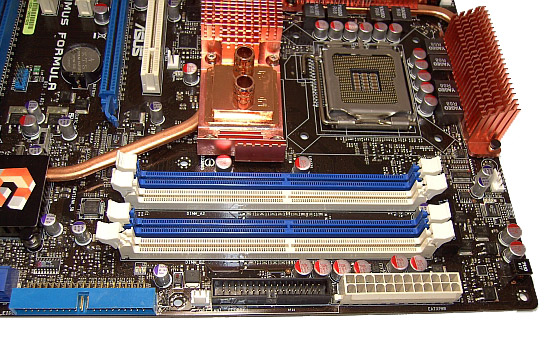
The DIMM sockets are located a little lower on this board; ASUS has moved the slots closer to the Northbridge, shortening the PCB trace lengths (in theory reducing inductance and signal crosstalk). We had no issues inserting or removing our 4x1GB memory modules from the DIMM slots, even with a long graphics card inserted into the primary PEG slot. Memory voltage is supplied by a two-phase power circuit, which has become another ROG motherboard trademark. With 4GB of memory becoming increasingly popular, the lower impedance should help sustain stable high MHz memory clocking. The 24-pin ATX header is located conveniently at the edge of the board, alongside the floppy drive and a fan/probe connector, all accessible without hindrance from other components.

CPU power is supplied by an eight-phase analog PWM circuit, using high quality Yageo inductors. The 8-pin 12V connector is located at the top left corner of the board, just behind the PS/2 connectors. This board is clearly aimed at users who are likely to water-cool both the CPU and Northbridge. Mounting air coolers that use thumbscrews for attachment is made a little awkward by the close proximity of the large Northbridge heatsink around the lower left corner of the CPU socket. A fan header is placed at the top edge of the board. We also have an SPDIF output header, and the top left of the board is home for the supplied LCD post display connector. Thankfully, ASUS listened to users and the LCD post display comes with its own cable allowing for user-selected placement.
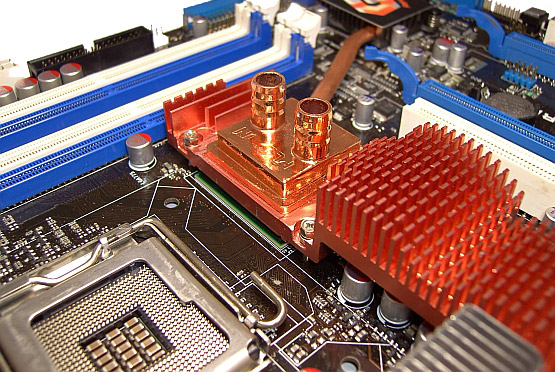
Moving on, we find the elaborate ROG heatsink designs ASUS employs to cool the Northbridge, Southbridge, and PWM areas. For the Maximus Formula SE, ASUS has employed a hybrid design consisting of a water block that is spot epoxy glued to a large heatsink that connects the Southbridge and Northbridge together with a heatpipe. The heatpipe continues further, covering part of the separate PWM heatsink, with an Aluminum fin section. A small fan is supplied that clips onto the Aluminum section of the heatsink, helping to cool the Northbridge and we suggest using it.
ASUS supplies both 3/8" and 1/2" tubing adaptors together with spring clamps to hold tubing in place. Unfortunately, our high flow pumps (Petra Top DDC Ultras) were too much for the 1/2" spring clamps. Using the supplied 1/2" clamps, our tubing actually came loose and shot off the barbs. Bottom line: screw type hose clips are a safer bet for high-pressure water cooling pumps. Initial testing with the stock solution using our upper-end water-cooling solution showed little temperature gains over air-cooling using 2x120mm fans over the area. During testing our water block actually came loose, and we were a little surprised to find that there was little contact between the heatsink and NB water block. No thermal paste was used in the stock design to ensure contact between the spots of epoxy glue that had been used to bond the two surfaces together.
Because there was very little contact between the Northbridge water block and the heatsink, it's no wonder there were no initial gains from using water-cooling. We re-attached the block using a combination of thermal paste (in the center of the block) and epoxy (around the perimeter). We also checked the contact between the chipset IHS (Integrated Heat Spreader) and the Northbridge heatsink assembly. The footprint left by the pad showed around a 60% contact surface, with the center of the NB IHS making very little contact with the heatsink. We scraped away the flaky thermal pad and used thermal paste in its place. The increased surface contact of the two modifications lead to a ~9C drop in load temperatures and certainly helped in overall board stability when overclocking. Needless to say, this is not the sort of thing users should be required to do on an "extreme" motherboard. Hopefully ASUS can improve their process and quality control on this aspect of the Maximus. In fact, ASUS has shipped us a new board that should arrive shortly so we can compare early production process to the current one.
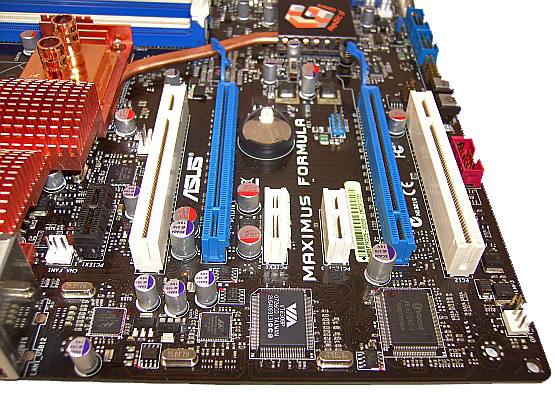
There are two PCI-E 2.0 x16 slots, both offering full x16 bandwidth for dual graphics cards. The remaining slots are three PCI-E x1 (the black slot is reserved for the supplied SupremeFX II ADI based 8-CH Audio card), and two PCI 2.3 slots, placed in between the PCI Express slots. The wide PCI Express slot spacing should help airflow, especially with high heat producing cards such as the AMD HD 2900 series. Underneath the lower PCI slot, we have a fan and thermal probe header. Further to the right we have an on-board 1394a port connector and power and reset switches. One of the Internal USB connectors is placed over the lower PCI Express x16 slot; the other two internal USB connectors are situated to the right of the power and reset switches.
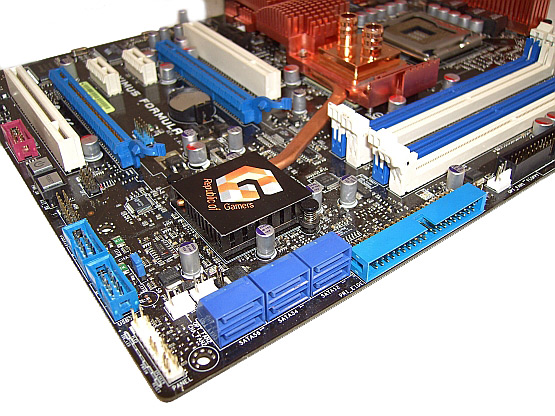
The Intel ICH9R Southbridge has the standard six on-board SATA sockets, placed at a 90 degree angle towards the right edge of the board. If the motherboard is to be mounted in small PC cases, it is wise to plug the SATA cables in before securing the motherboard into the case. Underneath the SATA ports we have the system panel connector, featuring ASUS' easy mount Q-Connector system. Two more fan headers and a thermal probe header sit behind the SATA ports.
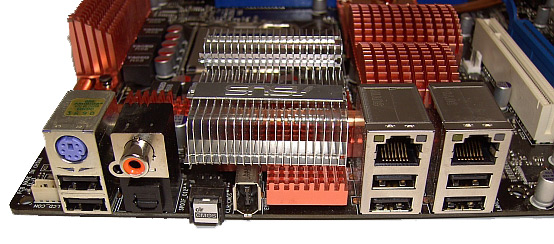
Rear IO ports feature a PS/2 keyboard port with 2 USB slots directly underneath; users with a PS/2 mouse will need a PS/2 to USB adaptor. A Coaxial S/PDIF output is also present, together with a TOSLINK output. To the right we have the Clear CMOS button, making it easy to clear the CMOS after the board is installed in a case. There is a rear FireWire port, dual Gigabit LAN (featuring teaming support), and four additional USB ports. ASUS also bundles 3DMark06 (Advanced Edition), STALKER, and Kaspersky anti-virus software with the board.

There are no surprises here; ASUS delivers the standard ROG color scheme consisting of blue and white slots, while sticking with the same overall layout we have seen in earlier ROG boards. There are eight on-board fan headers, which are controllable either through the BIOS or with the supplied PC Probe II software via the OS. The three OPT fan headers have probe connectors situated nearby and are compatible with probe related fan speed controls (the probes are sold separately). The whole board utilizes solid polymer capacitors, which are mandatory on the ROG series.
ASUS has also included a "Volt Minder" system that uses traffic light colored LEDs placed near the CPU, Northbridge, and Southbridge. These LEDs light up to signal the level of voltage applied; Green is safe or normal range, yellow for high voltage, and red is referred to as "crazy voltage levels" by ASUS - rightly so when you look at the available levels of voltage to these areas in the BIOS. Overall, the general layout, features, and slot placement is ideal for an overclocking oriented motherboard.

The DIMM sockets are located a little lower on this board; ASUS has moved the slots closer to the Northbridge, shortening the PCB trace lengths (in theory reducing inductance and signal crosstalk). We had no issues inserting or removing our 4x1GB memory modules from the DIMM slots, even with a long graphics card inserted into the primary PEG slot. Memory voltage is supplied by a two-phase power circuit, which has become another ROG motherboard trademark. With 4GB of memory becoming increasingly popular, the lower impedance should help sustain stable high MHz memory clocking. The 24-pin ATX header is located conveniently at the edge of the board, alongside the floppy drive and a fan/probe connector, all accessible without hindrance from other components.

CPU power is supplied by an eight-phase analog PWM circuit, using high quality Yageo inductors. The 8-pin 12V connector is located at the top left corner of the board, just behind the PS/2 connectors. This board is clearly aimed at users who are likely to water-cool both the CPU and Northbridge. Mounting air coolers that use thumbscrews for attachment is made a little awkward by the close proximity of the large Northbridge heatsink around the lower left corner of the CPU socket. A fan header is placed at the top edge of the board. We also have an SPDIF output header, and the top left of the board is home for the supplied LCD post display connector. Thankfully, ASUS listened to users and the LCD post display comes with its own cable allowing for user-selected placement.

Moving on, we find the elaborate ROG heatsink designs ASUS employs to cool the Northbridge, Southbridge, and PWM areas. For the Maximus Formula SE, ASUS has employed a hybrid design consisting of a water block that is spot epoxy glued to a large heatsink that connects the Southbridge and Northbridge together with a heatpipe. The heatpipe continues further, covering part of the separate PWM heatsink, with an Aluminum fin section. A small fan is supplied that clips onto the Aluminum section of the heatsink, helping to cool the Northbridge and we suggest using it.
ASUS supplies both 3/8" and 1/2" tubing adaptors together with spring clamps to hold tubing in place. Unfortunately, our high flow pumps (Petra Top DDC Ultras) were too much for the 1/2" spring clamps. Using the supplied 1/2" clamps, our tubing actually came loose and shot off the barbs. Bottom line: screw type hose clips are a safer bet for high-pressure water cooling pumps. Initial testing with the stock solution using our upper-end water-cooling solution showed little temperature gains over air-cooling using 2x120mm fans over the area. During testing our water block actually came loose, and we were a little surprised to find that there was little contact between the heatsink and NB water block. No thermal paste was used in the stock design to ensure contact between the spots of epoxy glue that had been used to bond the two surfaces together.
Because there was very little contact between the Northbridge water block and the heatsink, it's no wonder there were no initial gains from using water-cooling. We re-attached the block using a combination of thermal paste (in the center of the block) and epoxy (around the perimeter). We also checked the contact between the chipset IHS (Integrated Heat Spreader) and the Northbridge heatsink assembly. The footprint left by the pad showed around a 60% contact surface, with the center of the NB IHS making very little contact with the heatsink. We scraped away the flaky thermal pad and used thermal paste in its place. The increased surface contact of the two modifications lead to a ~9C drop in load temperatures and certainly helped in overall board stability when overclocking. Needless to say, this is not the sort of thing users should be required to do on an "extreme" motherboard. Hopefully ASUS can improve their process and quality control on this aspect of the Maximus. In fact, ASUS has shipped us a new board that should arrive shortly so we can compare early production process to the current one.

There are two PCI-E 2.0 x16 slots, both offering full x16 bandwidth for dual graphics cards. The remaining slots are three PCI-E x1 (the black slot is reserved for the supplied SupremeFX II ADI based 8-CH Audio card), and two PCI 2.3 slots, placed in between the PCI Express slots. The wide PCI Express slot spacing should help airflow, especially with high heat producing cards such as the AMD HD 2900 series. Underneath the lower PCI slot, we have a fan and thermal probe header. Further to the right we have an on-board 1394a port connector and power and reset switches. One of the Internal USB connectors is placed over the lower PCI Express x16 slot; the other two internal USB connectors are situated to the right of the power and reset switches.

The Intel ICH9R Southbridge has the standard six on-board SATA sockets, placed at a 90 degree angle towards the right edge of the board. If the motherboard is to be mounted in small PC cases, it is wise to plug the SATA cables in before securing the motherboard into the case. Underneath the SATA ports we have the system panel connector, featuring ASUS' easy mount Q-Connector system. Two more fan headers and a thermal probe header sit behind the SATA ports.

Rear IO ports feature a PS/2 keyboard port with 2 USB slots directly underneath; users with a PS/2 mouse will need a PS/2 to USB adaptor. A Coaxial S/PDIF output is also present, together with a TOSLINK output. To the right we have the Clear CMOS button, making it easy to clear the CMOS after the board is installed in a case. There is a rear FireWire port, dual Gigabit LAN (featuring teaming support), and four additional USB ports. ASUS also bundles 3DMark06 (Advanced Edition), STALKER, and Kaspersky anti-virus software with the board.










24 Comments
View All Comments
takumsawsherman - Saturday, November 10, 2007 - link
Now, we have a close to $300 board, and what we get for that is no Firewire800 support. Amazing. But the sick part is that for $300, you also don't get:1. PS/2 mouse. Obviously too expensive to implement.
2. Poorly attached cooling (a perennial issue dating back at least to A7N8X 2.0)
3. No parallel or serial, not that anyone would use it. But I'm looking for something they could maybe afford to add when you drop $300 on a motherboard.
4. Maybe it's just me, but I don't see eSATA, either.
What a waste of time. Heck, I think the Tyan 1846S/L/A from 1998 had more features, and for $115. At the time, that seemed expensive. Great board, with great support. Now, off to the forums to see what issues the Maximus users are having. I'm betting it's not been all fun and games for them.
Speaking of fun and games, in 1999, Tyan had a board with a front panel socket surrounding the front panel headers. When I called them, they said they were pushing for a standard interface for that pain in the butt stuff nobody likes to install. One connector. Never happened. Now, Asus should do the same thing. Instead of just moving it out of the case (which is better than the current system, I admit), why not put the connector on the board, and push other mobo manufacturers and case manufacturers to support it.
GlassHouse69 - Sunday, November 11, 2007 - link
yeah. parallel and serialthey are actually useful if you just dont load up your ipod and play l33t games that pwn.
no firewire 800 also. it would be like a 50 cent piece of hardware. id say most 2 dollars.
300 dollars equates to 15 dollars of rediculous cooler that is not needed, 25 dollars at most for the board, and the rest kiddie shit ripoff. People forget the articles 2 years about how much really a "high end" motherboard should cost.
thanks for playing.
LoneWolf15 - Sunday, November 11, 2007 - link
I couldn't agree more on the PS/2 ports. ASUS' decision to do this on their recent boards has caused me to strike them from my list. I use a KVM to allow me to troubleshoot the systems of others, and PS/2 still works the best for me in this.No eSATA ports on the backplate would be forgivable on a board that didn't cost this much, but at near $300, it's ridiculous. Admittedly, eSATA is kind of a future thing, but for the price, you should expect some future proofing. (I checked ASUS' website and found no mention of an eSATA port bracket either, so I'm guessing it's not there)
I no longer need parallel, though serial is occasionally useful for console-port programming. As for FireWire 800, as much as I'd like to see it adopted, so far it's just not happening on the PC, and I won't fault ASUS for that.
I think Gigabyte's GA-X38-DQ6 offers a better layout in almost every way except maybe the SATA ports (which is a judgement call - I like the front-port connectors ASUS uses, but they won't work well for every case). And Gigabyte is smart enough to provide both PS/2 ports while still fitting more USB ports, dual FireWire, and all the requisite audio ports. Gigabyte also has a well thought out eSATA port bracket.
ASUS just loses out on this one. (note: that said, I'll never pay $300 for a mainboard.)
Missing Ghost - Saturday, November 10, 2007 - link
I fully agree with you. 300$ is a lot for a board, for that price you can expect workstation quality. eSATA and serial COM ports are definitely ports that I do use. Also I'm sure the board has tons of problems since it's made by ASUS.Axbattler - Saturday, November 10, 2007 - link
1. I am not too offended by that. At least it has two more USB ports than Abit's iX38 Quad-GT. That said, Gigabyte can fit both two PS/2 and 8 USB ports in some boards (those without Serial/Parallel ports). It comes down to the connectivity you need - there is a finite amount of space at the back and you will sacrifice something. I'll take two USB ports over one PS/2.2. Problematic indeed.
3. Goes back to point 1. I think it's acceptable for parallel or serial to go. Although optional brackets would've been nice. For the cost though, it is more appropriate in my view to see Firewire 800..
4. ...and eSATA. What were they thinking? They are basically saying that if you want X38 and eSATA, you have to get a DDR3 boards.
It looks like while price of Intel CPU today do not have a big mark up compared to AMD at their peak, top end motherboards based on the S775 is a lot more expensive than similarly classed motherboard back then. I remember that Asus's motherboard around the 939 chipset were around £130 back then, somewhat comparable than their top P35 offering today, but well short of most of their x38 - and the MaximusExtreme is close to £200.
Raja Gill - Saturday, November 10, 2007 - link
Some of the points made do show how the makret for extreme products has changed over the last 18 months. For the ROG boards, the users who provide the greatest amount of 'heard' feedback are generally the extreme users. This is probably why the emphasis has shifted away from entry 'workstation level' ports. The ragged edge top end enthusiasts do not seem to mind sacrificing the additional ports for additional board speed, as they would see it at least. Additional peripheral ports do require extra BIOS code and onboard resources (not a great excuse from me, but one of the only ones I can really give). There is of course no justification one can provide in either direction that satisfies both types of users requirements. We can guess that cost and profit margins play a large part in decisions too. What we have seen in recent years is Asus also offerring 'WS' boards that are aimed at overall compatibility and the ports that general PC users deem essential. At this time we have no idea at this time if a WS level variant featuring the X38 chipset is planned.regards guys
Raja
Axbattler - Saturday, November 10, 2007 - link
Is the ROG series significantly better than the WS series when it comes to board speed/tweaks? Which board (out of any manufacturers) have the best fan monitoring/control of all (and in the event of a tie - which has the best layout/connectivity)?IntelUser2000 - Friday, November 9, 2007 - link
Boo on the useless expensive products!! Chipsets are the least beneficial in terms of R&D spent.carpediem2u - Friday, November 9, 2007 - link
I was wondering about this question due to this article.Could it be possible to disable of the dual cores in a Quad core CPU?
Since they are made of two dual core CPU's?
Raja Gill - Friday, November 9, 2007 - link
There is no function in 0505 BIOS to turn off a core or cores, I have not tried the later BIOS releases...